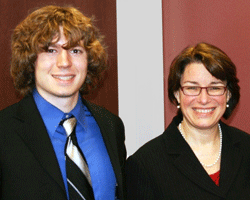You reached this page through the archive. Click here to return to the archive.
Note: This article is over a year old and information contained in it may no longer be accurate. Please use the contact information in the lower-left corner to verify any information in this article.
Students take lead on NSF computing grant
May 13, 2010
|
|
| Senator Amy Klobuchar recently met with Patrick Garrity '12 (in photo) to learn more about the innovative work he and Timothy Yates '12 have been doing at St. Olaf. |
When Associate Professor of Computer Science Richard Brown received a National Science Foundation grant to produce educational materials last summer, he never would have believed that his student workers would end up pushing the work a year ahead of schedule. But they have.
The hard work has paid off for Timothy Yates '12 and Patrick Garrity '12, who began working on the WebMapReduce project over the summer. The work involves trying to make map-reduce computing — a complex strategy for solving problems within vast amounts of data by processing the data in two stages using computer "clusters" — more accessible to undergrad computer science students. During the past year their work has been presented at two national conferences and is gaining recognition from faculty at institutions around the world.
The grant was to develop software to make it easier for teachers and professors to teach map reduce computing (also known as parallel computing) in introductory-level computer science courses. At the Special Interest Group on Computer Science Education national conference in Milwaukee earlier this year Garrity, Yates, and Mike Gesme '10 got the opportunity to be one of two academic demonstrations at Intel's prominent booth at the conference. Through this event they spoke with more than 40 professors who are interested in using their new materials to teach parallelism in their classrooms.
 |
| Timothy Yates '12, seated at the keyboard of a cluster of multicore computers, and faculty member Richard Brown. St. Olaf's new parallel computing room has the capacity to house one of the world's 500 most powerful computing systems. |
Validating the work
Yates says the conference has been one of the best parts of the project so far. "I was surprised how much interest it generated," he says. "Suddenly we were taking business cards from professors from all over the world, many of whom were eager to be able to incorporate it in their classes. It really validated all the work for me."
Their success in the project led Garrity and Yates to be chosen from 300 applicants to present at the 2010 Posters on the Hill session in Washington, D.C., last month. The event recognizes distinguished undergraduate research projects across all disciplines from around the country. Although Yates was not able to attend, Garrity got the opportunity to meet with various legislators and their staffs, as well as plug the importance of undergraduate research in the United States.
Minnesota Senator Amy Klobuchar praised Garrity and Yates as examples of excellence. “Minnesota has a long tradition of innovative scholarship and Patrick and his fellow teammates exemplify the values needed to continue this tradition,” she says.
Currently the team is working to get the materials ready to release to the public and testing it in classes at St. Olaf and at Macalester College, and soon at the University of Wisconsin–Eau Claire. After the release they will incorporate feedback to tailor the program to the needs of different schools.

